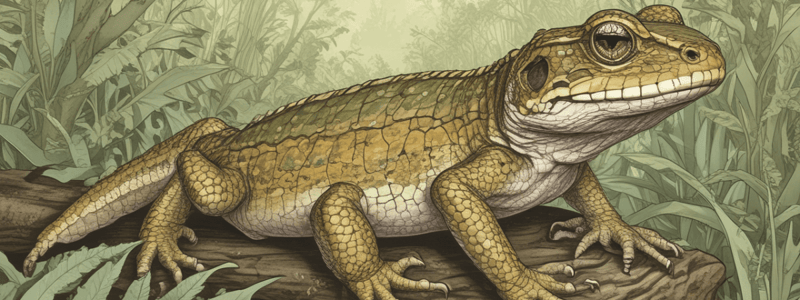Podcast
Questions and Answers
Match the following species with their role in Florida's ecosystems:
Match the following species with their role in Florida's ecosystems:
Turtles = Vital role in the state's ecosystems Lizards = Invasive species Snakes = Native species Crocodiles = Native species
Match the following species with the primary threat they pose to native ecosystems:
Match the following species with the primary threat they pose to native ecosystems:
Invasive reptiles = Predation on native species Invasive amphibians = Competition for limited resources Native reptiles = Spread of disease Native amphibians = Impact on the economy
Match the following with the most effective way to prevent the spread of invasive species:
Match the following with the most effective way to prevent the spread of invasive species:
Sustainable funding = Enforcing policies to prohibit the release of non-native species Researching invasive species = Creating policies to prevent further introductions Enforcing policies = Sustainable funding for control and prevention Implementing policies = Researching native species
Match the following species with the impact they can have on the economy:
Match the following species with the impact they can have on the economy:
Match the following species with the area most affected by their presence:
Match the following species with the area most affected by their presence:
Study Notes
Florida Reptiles: Turtles, Lizards, Snakes, Crocodiles, and Alligators
Florida is home to an incredible diversity of reptiles, including turtles, lizards, snakes, crocodiles, and alligators. These species play a vital role in the state's ecosystems, but their presence is also a source of concern due to the impact of invasive species.
Turtles
Turtles are a diverse group of reptiles found in Florida, with approximately five non-native species established in the state. Some of these turtles, like the Cuban treefrog, can cause harm through predation and competition with native species.
Lizards
Florida has seen at least 137 introductions of non-native amphibians and reptiles, with lizards being among the most invasive species. The state's largest established invader is the Burmese python, which can grow up to 20 feet long and has had devastating effects on native wildlife in the Everglades.
Snakes
Snakes in Florida include both native and non-native species, with about five non-native species established. Some snakes, like the Burmese python, are predators that can impact native species through predation and competition.
Crocodiles and Alligators
Florida is home to two native crocodilian species, the American crocodile and the American alligator. Both species play essential roles in their ecosystems, but their populations are threatened by habitat loss and invasive species.
Impacts of Invasive Species
The presence of invasive reptiles and amphibians in Florida can have significant impacts on native ecosystems. These species can cause harm through predation on native species, competition for limited resources, and the spread of disease. They can also affect Florida's economy and quality of life, as seen in the case of the Burmese python's impact on the Everglades ecosystem.
Preventing the Spread of Invasive Species
To slow the spread of invasive reptiles and amphibians in Florida, it is essential to find sustainable funding for their control and prevention. This includes enforcing policies that prohibit the release of non-native species without a state permit. Researchers also urge lawmakers to create enforceable policies before more species reproduce and become established.
In conclusion, Florida's reptiles, including turtles, lizards, snakes, crocodiles, and alligators, play a vital role in the state's ecosystems. However, the introduction of invasive species poses significant threats to native species, the economy, and quality of life. It is crucial to continue researching these species and implementing policies to prevent further introductions and control established invasive species.
Studying That Suits You
Use AI to generate personalized quizzes and flashcards to suit your learning preferences.
Description
Explore the diverse range of reptiles in Florida, including turtles, lizards, snakes, crocodiles, and alligators. Learn about the impacts of invasive species on native ecosystems, the economy, and quality of life. Understand the importance of preventative measures and sustainable funding for control and prevention.




